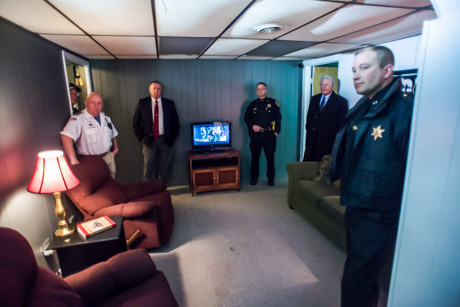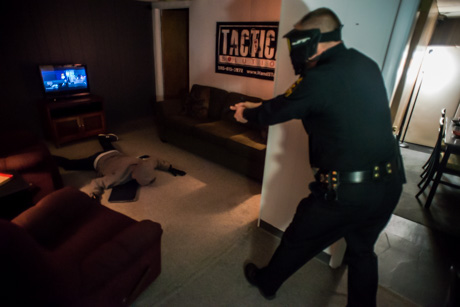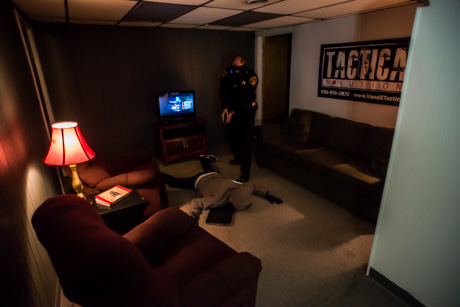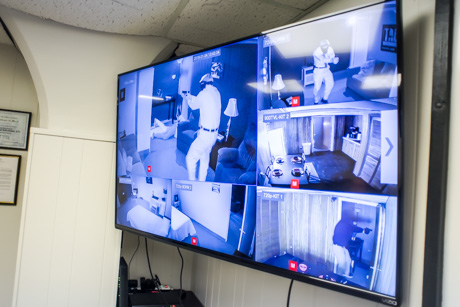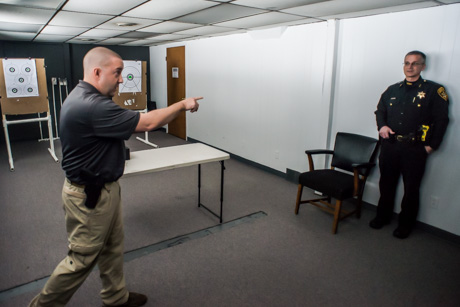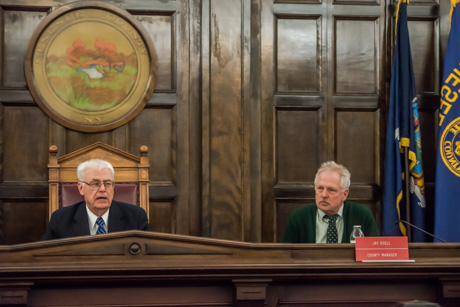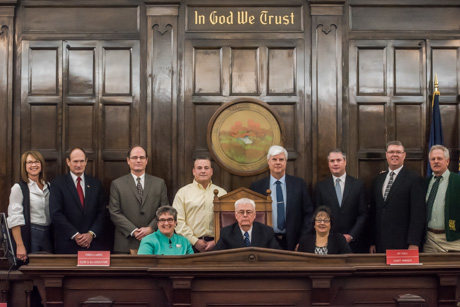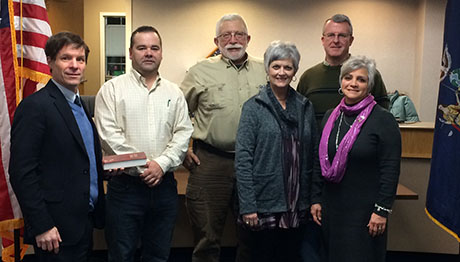If you found an intruder in your house, would you know what to do?
Even if you were armed, would you know what to do?
Or would you panic?
Training in advance of stressful situations is key to surviving potentially hazardous conflicts and defusing them safely for yourself, your family members and even the intruder.
M&S Tactical Solutions in Batavia has set up an Active Home Invasion System at its facility in the Harvester Center in Batavia.
It's designed to provide training for the company's primary clients, local residents who want to improve security in their home, especially if they keep a firearm.
Yesterday, Sheriff William Sheron and members of his command staff -- Greg Walker, Jerry Brewster, Bill Zipfel, and Joe Graff -- toured the new facility (along with Mercy medic Wade Schwab) and Zipfel and Graff both went through simulated home invasion scenarios to experience how the training works.
"I like it because it’s realistic," Zipfel said. "It's not like our tower. There’s actual furniture. It’s really nice."
While the AHIS is set up to train civilians, it's also used by local police officers to get extra training and practice in detecting and reacting to threats in real-life scenarios.
Participants, if armed, are armed with realistic-looking airsoft pistols and wear face masks.
When it's civilians going through, they are given a basic firearm safety course, even if previously trained, just to make sure everybody is on the same page, said M&S owner Jeff McIntire. Then they're put in a scenario to see how they handle it. McIntire and his staff monitor the home invasion scenario thorugh closed circuit video so they can review how things played out with the participants.
"We don’t give them anything at first," McIntire said. "We put them over there because we want to see what your natural reaction is. I want to see what you naturally do. Then we come back here and debrief. Now we can start actually talking about what to do."
One recent participant fired first and asked questions later. That's a measure, McIntire said, of how realistic and stressful the scenarios can be. The adrenaline pumps and your autonomic systems take over and pushes your mind into "fight or flight" mode.
Getting past those automatic responses is what training is about. Repetition helps build up a kind of muscle memory that helps you stay calm and make better decisions.
To help teach the importance of good decision making, not all of the "intruders" are hostile. They might be an Alzheimer patient who is convinced he's in his own home, or a neighbor just knocking on your door. The intruder might even be your wife home early from work. In other words, not every scenario is hostile but could end in tragedy without proper training.
And not every intruder deserves to be shot. A TV, McIntire noted, is not worth a person's life. Participants are taught to better recognize which intruders pose a real life or limb threat to themselves or a family member.
The scenario yesterday for Graff involved the chief deputy just returning home from work. There is an intruder going through his belongings in his bedroom. At some point, the intruder comes out of the room and Graff became aware he was there. In this case, Graff drew his pistol and shouted for the intruder to put his hands where he could see them and get on the ground. As the intruder went down, he was instructed to reach for his mobile phone in his pocket. Graff yelled for him to put his hands back up and the intruder fumbled with his phone and drop it. Graff did not fire.
In the other scenario, Zipfel came home, grabbed a beer and went in the bedroom to ly down. Then two intruders entered. They began searching the living room for items and Zipfel heard the noise. He crouched down, entered the room, spotted the intruder and ordered him to the ground. As he approached the intruder, the second intruder started to enter the room from the kitchen, gun pointed at Zipfel. Zipfel shot him.
In both cases, with their boss Sheriff Sheron watching, they made the right decision.
While officers who use the facility for training aren't earning any sort of certification, McIntire said he recognizes the need for officers to get numerous repetitions of potentially dangerous situations to help improve their decision making.
Whether civilian or officer, repetition and review are key training tools for improved performance.
Without training, McIntire, people often revert to what they've seen on TV or in a movie, and that's not a good place to be.
McIntire said, "We stress getting people to that point with muscle memory where they say, 'I don't have think. I just know what to do.' "
Top photo: The tour in the living room apartment. Next two photos, Graff during his scenario. Fourth photo, monitors showing Zipfel's scenario. Bottom, McIntire and Walker in the facility's firing range (where airsoft guns are used).


